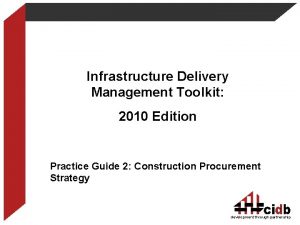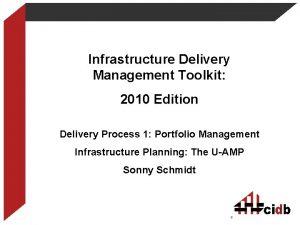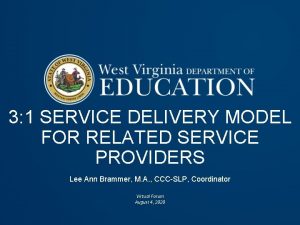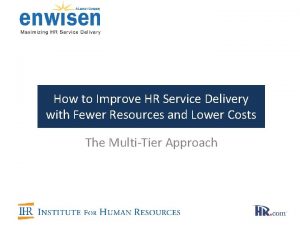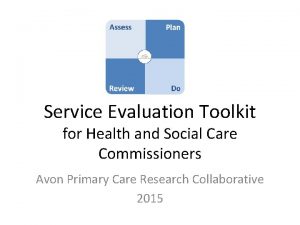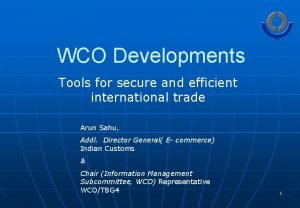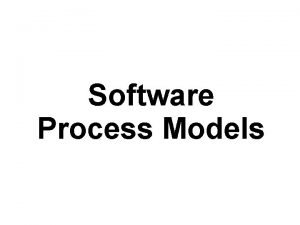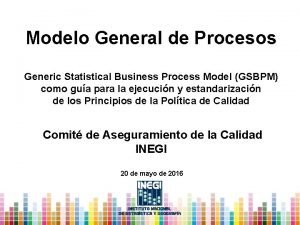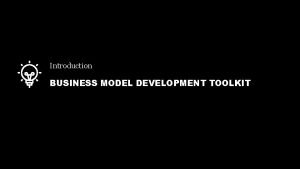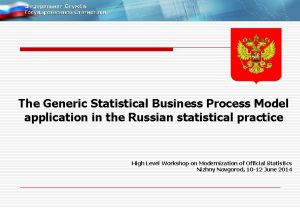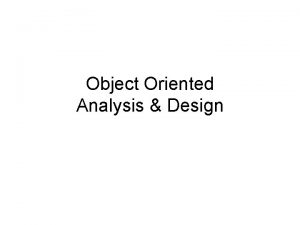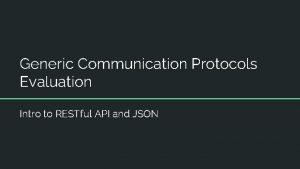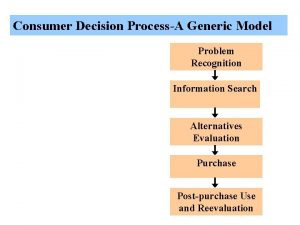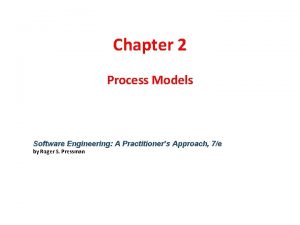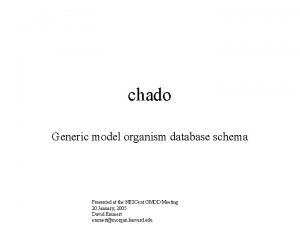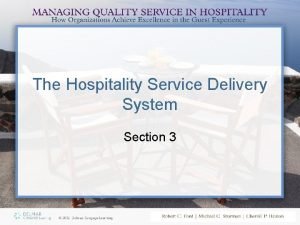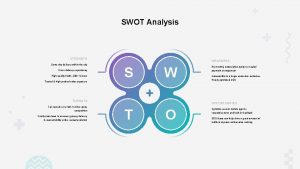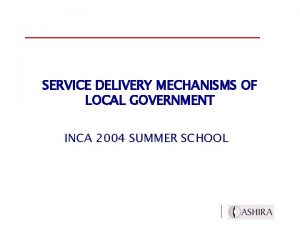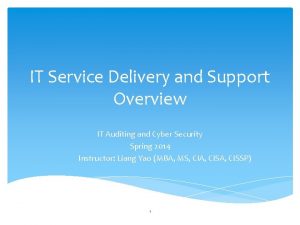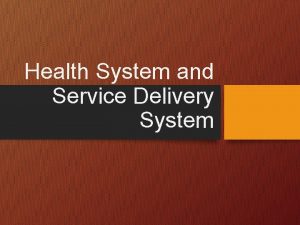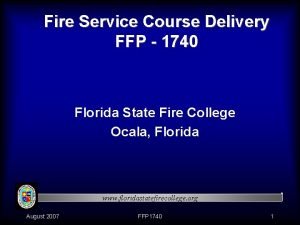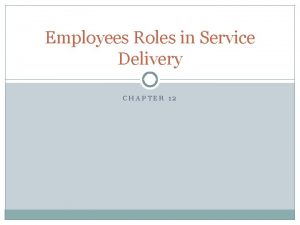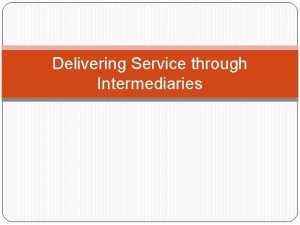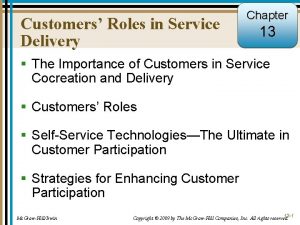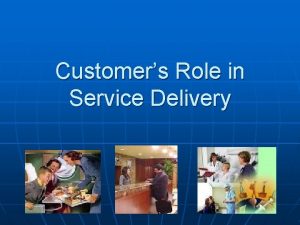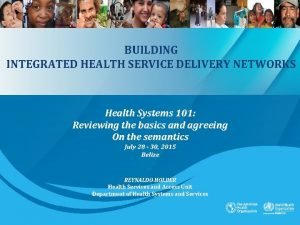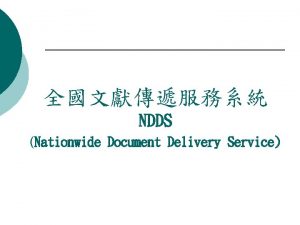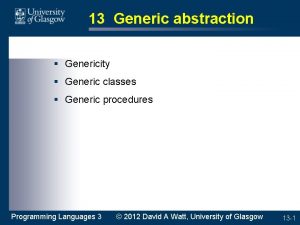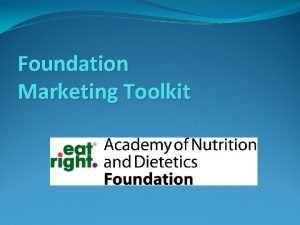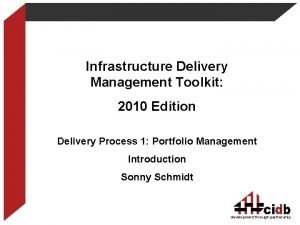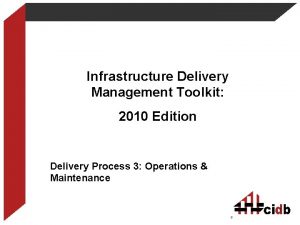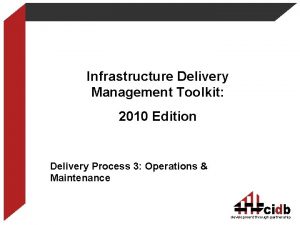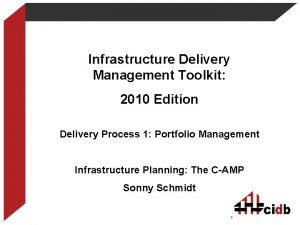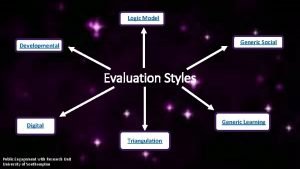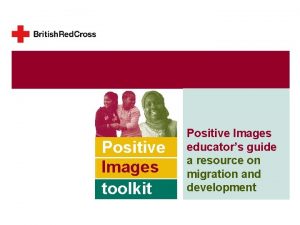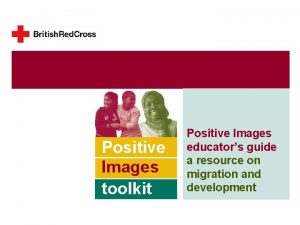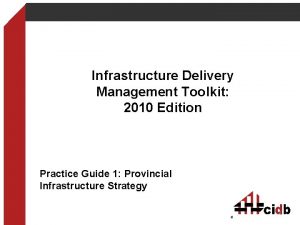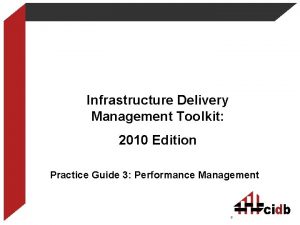Generic Service Delivery Model Toolkit Guide version 1

































- Slides: 33

Generic Service Delivery Model Toolkit Guide version 1

What the toolkit consist of –A Power. Point presentation as the basis to document the service delivery model (SDM). –Templates and information documents (linked to Power. Point) to assist and guide the user.

How to use the toolkit –The toolkit is developed to be used by an informed user. –The toolkit guides the user through the process and generates the documented SDM (Service Delivery Model). –This is a generic toolkit aimed at facilitating the development of a SDM (Service Delivery Model). It does not provide specific answers to an entity and the users are required to formulate their own model based on their knowledge and experience. –Not all the activities may be relevant to all entities. The user must decide which steps are appropriate for the entity. It is recommended that the user record the reasons why a specific activity is not relevant for the entity. This will give perspective to the documented SDM (Service Delivery Model).

How to use the toolkit –As this is a generic toolkit, it may arise that some users identify additional activities that are required. This is encouraged and it is also requested that such steps, ideas and suggestions be forwarded to the DPSA (Department of Public Service and Administration) for enhancement of the toolkit. –This toolkit provides an opportunity for all levels of government to participate and it is hoped to stimulate innovation and unlock unused intellectual capacity within the government service.

Content of a SDM Definition of the service delivery model (SDM) toolkit A concise toolkit to annually assist and support management in determining the most suitable operating model to meet mandated and overall service delivery expectations. It enhances existing management processes. It therefore, does not add to workload. – Confirmation of mandated responsibility – An informed list of services to be provided an indication of who would provide the services to which clients – The pros and cons of current approaches to service delivery – A description of how best service provision should be operationally organized internally and through working arrangements with other Departments or third party entities – A detailed analysis of how support services can be best organised to support front-line service delivery – Discussion of alternate service delivery mechanisms or operational improvement for each area of service – Information Technology requirements of each service – HR and general capacity requirements of each service – Risks and constraints of delivery, with mitigation plans

General guidance as derived from leading practices – – – – Most SDM’s attempt to simplify the models so that it is accessible to all officials and recipients. The recipients determine how the service should be rendered and what the standards should be The SDM attempts to force the officials to consider existing limitations and risks SDM attempts to identify and reduce duplication of services by different government agencies SDM is used as a tool to identify areas for collaboration between departments – – – The SDM either includes a PM-system or has a compulsory link to a PM-system. E-Government is not seen as an innovation by itself, but merely one of the essential drivers for innovation and service delivery in government. Most models contain some element of Total Quality Management / Continuous Improvement. Standards set by central government are used to get minimum standards in place, after the culture of quality service has been settled, the users set standards. Best-practice models acknowledge that service delivery has to be done in partnership with the private sector. SDM’s generally attempt to be concise, but many of the principles/aspects (e. g. alternate service delivery methods) are described and regulated by pre-existing procedures/models.

Content Overview of the process Preparation Confirm mandates Define services Methods of delivery Risks and assumptions

Overview of the process 1. PREPARATION Service Delivery Analysis 2 Confirm the Mandate 3 4 Defi ne Ser vice s Ana lyse Met hod s of Deli very 5 Risk s& Con strai nts Actions for Province Pl an ne d S er vi ce D eli ve ry M o de l Short Term Long Term Medium Term

Content Overview of the process Preparation Confirm mandates Define services Method of delivery Risks and assumptions

1. PREPARATION Activity Guidance Activity 1. 1 Identification 1. 2 Preparation Activity Guidance Identification of the SDM Ø The SDM that will be documented should be identified in terms of date compiled, department, version etc. Ø If the SDM has been documented before, then this process should be recorded as an update of the previous SDM. Background information for documenting the SDM Ø The information in the general guidance should be reviewed for updates. Ø The review should result in a fresh understanding of the relevant issues and critical issues or changes should be documented. Ø Examples of typical documents could include (not exhaustive) : • The National Spatial Development Plan • The Provincial Spatial Development Plan and/or Integrated Development Plan (IDP) • Provincial priorities • National/Provincial programme of action • The entity specific national, provincial and local government guidance SDM’s and other information • Notes on international practices to stimulate thought and ideas • Departmental Organisational structure, HR Plan and budgets

1. PREPARATION Activity Guidance Activity 1. 3 Current arrangements Activity Guidance Current arrangements Ø To assist with a structured approach to documenting the SDM it is necessary to record the current arrangements that are in place. Ø This will then be updated in the final SDM as agreed and formulated arrangements. Ø During the review of the SDM this should then be readily available as a starting point. Ø Examples of current arrangements could be: • Intergovernmental arrangements in terms of the IGR (Intergovernmental Relations) Act • Intergovernmental arrangements not in terms of the IGR (Intergovernmental Relations ) Act • Public entities attached to the entity • Significant joint programmes or projects with other government entities • PPP’s (Public Private Partnership’s) in existence • Outsourced, co sourced functions • Ownership of transversal systems or services and service level agreements attached thereto • Utilisation of transversal systems and service level agreements attached thereto

1. PREPARATION Activity Guidance 1. 4 Internal assessment Ø A key finding from the international best trends on developing SDM’s was that innovation and solutions answers often lie with middle management and functionaries at lower levels. Ø An internal assessment of how the SDM should be formulated may give all employees an opportunity to provide input towards refining the SDM. Ø The internal assessment should also aim to identify the “symptoms” of poor service delivery, non servicing of mandates or duplication of efforts etc. Ø The aim should be to record these symptoms at the start of the process and then as the SDM progresses, to assess whether the root causes are being addressed. Ø The symptoms relate closely to the risk and assumptions and should therefore be recorded in the risk matrix. The internal assessment can take the following format: • Workshops with the staff and management • Inputs from internal and external audit • Inputs from the results of the performance management system • Own internal identification of symptoms • The strategic plan

1. PREPARATION Activity Guidance Activity 1. 5 External assessment Guidance Ø A key finding from the international best trends on developing SDM’s was that clients decided on what the services should be. Ø In a way this relates to the principles of Batoho Pele where it is necessary to establish a client expectation. Ø Once this expectation has been established the entity can then plan, execute and report according to this expectation. Ø Batho Pele further requires that the entity should provide explanations on matters that could not meet the clients expectations. Ø The external assessment therefore refers to the process of establishing what the client expectations were and how this was met. Ø It should be noted that core service departments are the external clients of the service departments (such as finance and human resources). Ø The format of the external assessment depends on the entity’s particular circumstances but can include the following: • Surveys • Workshops aimed to formulate service level agreements • Known needs of the public and core departments • Interviews • Etc.

1. PREPARATION Activity Guidance Activity 1. 6 Additional steps Guidance Ø As mentioned in the introduction, the toolkit is a generic toolkit. Ø A particular entity may have additional activities which may be useful to include in the background assessment. Ø A primary aim of documenting the SDM is also to stimulate innovation. Ø Activities that could enhance innovation is also encouraged. 1. 7 Section summary Ø The toolkit guides the user through steps where findings, evaluations, and ideas etc are recorded. Ø This could generate a significant amount of information and care should be taken not to loose focus. Ø To ensure that the process stays focused it is recommended that all the information generated in the previous section should be reviewed and the critical issues that needs to be taken forward is documented in the section summary. Ø It is important that all the issues for tracking are rooted to the risk and assumption matrix.

Content Overview of the process Preparation Confirm mandates Define services Method of delivery Risks and assumptions

2. CONFIRM MANDATES Activity Guidance Activity Purpose of this step Guidance Ø The purpose of this step is to ensure that there is a comprehensive understanding of political and legislative objectives and mandates to be reflected in the final SDM Ø Begin by researching what type of services are typically being provided by similar organizations/Departments internationally and locally. Ø This will enable a comparison to be made with our own service offering in phase 3 of the SDM. Typical Input documents may include: • Legislation, such as The Constitution, Systems Act, Structures Act etc • Regulations • Departmental and provincial strategic planning documents • Departmental operational planning documentation • Departmental budgets • Departmental performance management system and documentation • Annual reports • Auditor- General reports

2. CONFIRM MANDATES Activity Guidance Activity Purpose of this step Guidance Outputs for this step • List of mandated services, both legislated and political • Note any possible alterations or inclusions to the current mandate. • Highlight potential future service requirements or issues • List service delivery expectations/requirements stemming from strategic objectives – both Departmental and Intergovernmental • Risks associated with the mandates • Possible opportunities for inter governmental co-operation

2. CONFIRM MANDATES Activity Guidance Activity Generic steps for the confirmation of all mandates Guidance Ø It is normally perceived that the mandates of government entities are well known and well covered, however it still happens that departments do not cover some of their mandates. Ø Mandates are also open to interpretation. Ø A government entity may be of the opinion that the mandates are covered whilst this view may not be shared by recipients and other entities. Ø For this reason the following basic steps are recommended to confirm the mandates: • Record the mandates from source • Document the high level services that would give effect to the mandates • Document the high level client expectation • Evaluate the existing mandates against the results of the previous steps. Ø The above process will ensure that a common understanding regarding the mandates exist. Ø To further understand confirm the mandates it is recommended that the following activities be performed: • Formulate the risks associated with the mandates (if any) • Formulate assumptions associated with the mandates

2. CONFIRM MANDATES Activity Guidance Activity 2. 1 Confirm legislative mandates 2. 2 Confirm political mandates and priorities Guidance Ø Mandates that have been allocated to the entity through legislation should be recorded. Ø It is recommended that the entity should record what they actually need to do and not just a list of Acts that contains these mandates. Ø Political mandates and priorities refers to the mandates formulated through political processes. Ø These mandates support the constitutional mandates but put a priority aspect to it. Political mandates can be communicated in various forms such as speeches or programme of action. Ø It is recommended that a good understanding of guiding and strategic documents are obtained before the political mandates are confirmed. Ø Examples of relevant documents are: • National programme of actions • National spatial development framework • Provincial spatial framework and growth and development strategies

2. CONFIRM MANDATES Activity Guidance Activity 2. 3 Confirm departmental strategy Guidance Ø It is important to confirm and understand the departmental strategic plan when documenting the SDM. Ø The strategic objectives targets and measures should be aligned with the political and legislative mandates. Ø Understand the priorities of the department Ø The strategic plan will review how the entity currently views the mandates. 2. 4 Section summary Ø The section summary should contain the confirmed mandates, the high level service descriptions, risks and assumptions. Ø This summary feeds into the next process.

Content Overview of the process Preparation Confirm mandates Define services Method of delivery Risks and assumptions

3. DEFINE SERVICES Activity Guidance Activity Purpose of this section Guidance Ø The purpose of this section is to evaluate the current services that is offered against the high level services formulated in the previous section. Ø The aim is to refine the service offerings to the extent that it is aligned to the mandates and that it is possible to progress towards the next step where the modes of delivery will be evaluated. Ø It may be difficult to decide to what level of detail the services should be described. Ø This decision rests with the user, but the following guidance are provided: • The identification of a recipient may indicate the required level of the description • It should be possible to consider the modes of delivery in a meaningful manner • It should not result in a long list of services that essentially serve the same recipient and where the modes of delivery would be similar. In this case the description should move one level higher

3. DEFINE SERVICES Activity Guidance Activity 3. 1 Define the existing services Guidance Description of the service Ø It is essential that the description of the services are defined as accurately as possible and in a manner that facilitates the development of an SDM. Ø The following key features have been identified as guidance for the description: • The service description should describe what service will be delivered and what the recipient receives • It should be possible to link the service to a mandate • It should be possible to consider different modes of delivery for the services • It should be possible to identify the primary recipient of the services • It should be possible to measure the service. Ø Accommodating the above factors in the description of the service would render it being adequate for the SDM. Ø Process maps of the identified services could assist with this activity

3. DEFINE SERVICES Activity Guidance Activity 3. 2 Evaluation Guidance of existing services against services formulated in the previous section 3. 3 Identification of the recipient of the service and measurability of service Ø During the confirmation of the mandates, high level service descriptions and client expectations were formulated. Ø This had the purpose of ensuring that the mandates are understood by all and that an expectation could be developed of what it is that the entity would deliver. Ø The current services that have been documented can be compared to the high level service expectations that was formulated in the previous section. The current services should then be aligned with the high level service expectations. Ø For each service it is necessary to document who the recipients are and how the service can be measured. Ø This forms the basis of formulating the appropriate modes of delivery.

3. DEFINE SERVICES Activity Guidance 3. 4 Section summary Ø The section summary should contain the refined services, who the services are being delivered to and how it can be measured. Ø New or updated risks and assumptions should be recorded and routed to the risk matrix

Content Overview of the process Preparation Confirm mandates Define services Method of delivery Risks and assumptions

4. METHOD OF DELIVERY Activity Guidance Activity Purpose of this section Guidance Ø The purpose of this step is to understand how internal and external services could be better delivered from a short, medium and long term perspective. Ø This should include an examination of the aspects of PEOPLE, PROCESS & TECHNOLOGY. Ø The current situation should be analyzed to determine whether or not it is effective, efficient and delivering on promises to the recipient. If not, we should consider changing it. Ø Having an open mind is very important. Ø One should always try to remain abreast of current trends and more effective and efficient ways of operating. Ø It is also helpful to benchmark one’s self against other organisations and methods of delivering services. Ø People, Process and Technology should not be evaluated separately. Ø They cannot occur in sequence, but must occur in parallel. Ø The selected mode of delivery will impact on the technology solution, which will impact on the HR requirements, and vice versa.

4. METHOD OF DELIVERY Activity Guidance 4. 1 Document the current method of delivery 4. 2 Evaluate the current methods against assumptions, risks, constraints etc. Ø No specific guidance for the this activity Ø Throughout the development of the SDM risks, assumptions, constraints, symptoms etc. have been formulated. Ø All these factors influence the ability of the entity to deliver services in some way or another. Ø During this activity all these factors should be brought into account and the current method of delivery critically examined against these factors. Ø For example, if the current method of delivery requires that there is a 100 skilled workers in a region needed to deliver the service and there is an assumption that there is a skill shortage and that only 10 workers would be available then the mode of delivery may have to change. If the constraint regarding the shortage of skilled workers is ignored then the organization would be set up to fail.

4. METHOD OF DELIVERY Activity Guidance Activity 4. 3 Evaluate people, process and technology Guidance Ø This activity relates very closely to the previous activity with a specific focus on people, technology and process. Ø Detail guidance on how this will effect the method of delivery is difficult as every situation would be different. However, in considering this the following could be taken into account: Should services be outsourced, co sourced or delivered in house. Should the services be delivered transversally across government (either by this entity on behalf of other entities or by other entities where this entity becomes a client. ) The phased approach that would be needed for the implementation of technology

4. METHOD OF DELIVERY Activity Guidance Activity 4. 4 Formulate the refined method of delivery Guidance Ø Ø Ø The refined method of delivery is documented. It may be necessary to consider arrangements such as service level agreements, intergovernmental arrangements of PPP (Public Private Partnership’s) agreements. Ø If any aspect has been identified that could best be serviced by other entities or alternatively if the entity feels that it is best placed to provide the service on behalf of other entities, it should be raised and documented. Ø This information should then be considered by the next level of governance to facilitate proper coordination and integration. Ø In a situation where all the government entities follow a process to develop the SDM and all entities consider and route these issues to the next level, theoretically duplication of services should largely be eliminated. Ø It would also be possible for entities to deliver more specialized and high quality services if it is tasked to service several other entities. Ø An example could be for instance that the Department of Local Government provides the GIS (Geographic Information System) services for all other departments, local authorities and even private sector. It can then afford to established a highly effective and competitive service in this regard. 4. 5 Identification of issues for the next level of governance No specific guidance.

4. METHOD OF DELIVERY Activity Guidance Activity 4. 6 Section summary Guidance The section summary should contain the following: • The agreed methods of delivery • Key assumptions used in agreeing on the methods of delivery • Notes on critical decisions that was made during this section

Content Overview of the process Preparation Confirm mandates Define services Method of delivery Risks and assumptions

5. RISKS AND ASSUMTIONS Activity Guidance Ø Purpose of this section The purpose of this step is to take an objective view of the possible service delivery model option, and understand what could possibly stand in the way of implementation. All risks and constraints should be identified so that plans can be made to mitigate them.
 Infrastructure delivery management toolkit
Infrastructure delivery management toolkit Infrastructure delivery management toolkit
Infrastructure delivery management toolkit Infrastructure delivery management toolkit
Infrastructure delivery management toolkit Social service delivery models
Social service delivery models Push-in service delivery model
Push-in service delivery model Hr service delivery framework
Hr service delivery framework Service evaluation nhs template
Service evaluation nhs template Application delivery approaches in accenture liquid
Application delivery approaches in accenture liquid Wco data model
Wco data model Generic process model diagram
Generic process model diagram Modelo general de procesos
Modelo general de procesos Business model toolkit
Business model toolkit A generic strategy process model
A generic strategy process model Generic statistical business process model
Generic statistical business process model Ood
Ood Generic components of ooa model
Generic components of ooa model Generic statistical business process model
Generic statistical business process model Generic communication model
Generic communication model Selective problem recognition
Selective problem recognition Communication planning modeling construction deployment
Communication planning modeling construction deployment Generic model organism database
Generic model organism database What is hospitality service delivery system
What is hospitality service delivery system Courier swot analysis
Courier swot analysis Service delivery mechanism
Service delivery mechanism It service delivery and support
It service delivery and support It service delivery objectives
It service delivery objectives Fire service course delivery
Fire service course delivery Employees role in service delivery
Employees role in service delivery Effective service delivery
Effective service delivery Subway eef freef
Subway eef freef Customers and competitors
Customers and competitors Customer role in service delivery
Customer role in service delivery Integrated delivery network definition
Integrated delivery network definition National wide document delivery services
National wide document delivery services
